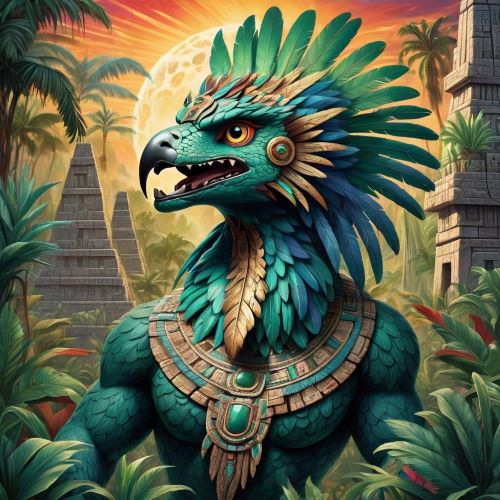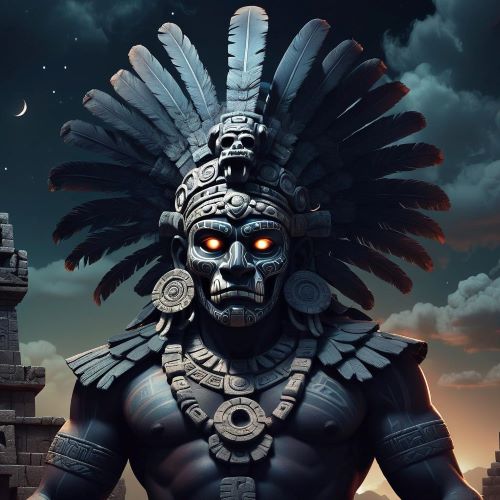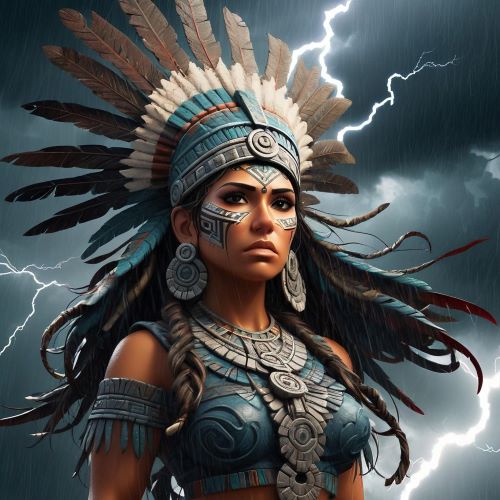Ehecatl : God of Winds
Listen
At a glance
| Description | |
|---|---|
| Origin | Aztec Mythology |
| Classification | Gods |
| Family Members | N/A |
| Region | Mexico |
| Associated With | Winds, Directions |
Ehecatl
Introduction
Ehecatl, a prominent figure in Aztec mythology, held the esteemed role of being the god presiding over air and winds, specifically those associated with rainfall. Acknowledged as a manifestation of the revered feathered serpent deity Quetzalcoatl, Ehecatl was occasionally referred to as Quetzalcoatl-Ehecatl.
Physical Traits
Ehecatl’s visual representation often featured distinctive elements, including a conical hat and a duckbill mask, both unique to him and symbolic of his connection to the wind. The architectural design of his temples was also noteworthy, typically resembling circular or curved pyramids with conical roofs. In Aztec art, Ehecatl’s portrayal varied, reflecting his dual nature as both a benevolent creator and an unpredictable force. At times depicted as a skeletal human figure adorned with jaguar pelts, signifying power and death, he would alternatively assume the resplendent feathered serpent form of Quetzalcoatl, his patron deity. Perhaps his most iconic feature was a mask with a wide-open mouth, symbolizing the rush of wind. Shells adorned his wrists and ankles, mimicking the rhythmic murmur of the ocean breeze, while a red, forked tongue flickered out, tasting the currents of the air.
Family
Ehecatl was recognized as one of the manifestations of Quetzalcoatl, a pivotal deity in Mesoamerican mythology. At times, he was denoted as Quetzalcoatl-Ehecatl. While commonly identified as an embodiment of Quetzalcoatl, the god of the feathered serpent, Ehecatl also shared connections with Xolotl, the fire god, who occasionally bore attributes associated with the wind. Despite these associations, Ehecatl had his distinct place within the divine family, being linked to deities overseeing rain, fire, and even death. This nuanced relationship highlighted the intricate and multifaceted nature of the winds he governed.
Other names
Ehecatl, translating to ‘wind’ in Nahuatl, was recognized by various names, each shedding light on different facets of his identity. Referred to at times as Quetzalcoatl-Ehecatl, this designation underscored his intimate association with Quetzalcoatl, the feathered serpent. The Aztecs believed that he emerged from flint on the day 9 Wind, presenting yet another appellation for him. However, “wind” was not his sole identifier. Additional epithets such as Yohualtepec (“Lord of the Night”), Ipalnemoani (“He Who Gives Life”), and Tlatemoani (“He Who Moves the Fire”) served to highlight the diverse powers of Ehecatl and the extensive range of natural phenomena under his governance.
Powers and Abilities
Ehecatl bore a myriad of responsibilities and attributes, solidifying his indispensable role in Aztec mythology. His connection to the winds, particularly those bringing rain, rendered him a crucial figure for agricultural prosperity. Furthermore, he held ties to the cardinal directions, diverse colors, and specific dates within the Aztec calendar. Ehecatl played a pivotal part in the Aztec creation narrative, notably in the formation of the fifth and ultimate sun. Tasked with orchestrating the movement of the sun and moon in their celestial courses, he played a celestial maestro of sorts.
Not confined to cosmic duties alone, Ehecatl bestowed upon humanity the maguey plant, a significant resource renowned for its spines and fermented juice, which served as the key ingredient in producing pulque, a traditional alcoholic beverage. Ehecatl’s influence extended beyond material gifts; he commanded the formidable power of the wind. Capable of summoning gentle breezes to nurture crops and kindle fires, he could just as easily unleash destructive hurricanes that uprooted trees and churned the waves.
His breath, a force of both creation and destruction, bore the capacity to carry prayers to the heavens and sweep away negativity. As a master of movement and direction, Ehecatl assumed the role of a celestial guide, steering travelers on their journeys and skillfully navigating the souls of the departed through the intricate paths of the underworld. In essence, Ehecatl’s multifaceted nature and versatile powers positioned him as a linchpin in the intricate tapestry of Aztec cosmology.
Modern Day Influence
Ehecatl’s visage graces contemporary murals and sculptures, while his name weaves through the fabric of traditional Mexican poetry and folklore. The mere utterance of “Ehecatl está contento” (“Ehecatl is happy”) accompanies the greeting of a refreshing breeze, a nod to the enduring presence of the wind god in everyday Mexican life. Yet, Ehecatl’s impact stretches beyond cultural symbolism, taking on newfound relevance in a world grappling with climate change and the escalating might of natural forces.
In the face of these challenges, Ehecatl’s message of wildness and transformation resonates with a renewed urgency. He serves as a reminder of the interconnectedness that binds all things, emphasizing the delicate equilibrium between creation and destruction and the ever-present influence of unseen forces shaping our world. Ehecatl isn’t merely a relic of the past; he exists as a whisper in the wind, a perpetual reminder that life itself unfolds in a dance of movement, change, and the breath of creation. As long as the wind continues to blow, Ehecatl persists – a restless spirit urging us to recognize the power and freedom inherent in the very air we breathe.
While explicit mentions of Ehecatl’s influence in modern times may be scarce, the broader scope of Aztec mythology, along with its pantheon of deities, has found representation across various forms of media. From video games and manga to anime, comics, and television, the rich and intricate tapestry of Aztec gods, Ehecatl included, captivates scholars and enthusiasts alike. These contemporary interpretations contribute significantly to our ongoing understanding of this ancient civilization and its profound beliefs.
Frequently Asked Questions
What is lorem Ipsum?
I am text block. Click edit button to change this text. Lorem ipsum dolor sit amet, consectetur adipiscing elit. Ut elit tellus, luctus nec ullamcorper mattis, pulvinar dapibus leo.
What is lorem Ipsum?
I am text block. Click edit button to change this text. Lorem ipsum dolor sit amet, consectetur adipiscing elit. Ut elit tellus, luctus nec ullamcorper mattis, pulvinar dapibus leo.
What is lorem Ipsum?
I am text block. Click edit button to change this text. Lorem ipsum dolor sit amet, consectetur adipiscing elit. Ut elit tellus, luctus nec ullamcorper mattis, pulvinar dapibus leo.
What is lorem Ipsum?
I am text block. Click edit button to change this text. Lorem ipsum dolor sit amet, consectetur adipiscing elit. Ut elit tellus, luctus nec ullamcorper mattis, pulvinar dapibus leo.
What is lorem Ipsum?
I am text block. Click edit button to change this text. Lorem ipsum dolor sit amet, consectetur adipiscing elit. Ut elit tellus, luctus nec ullamcorper mattis, pulvinar dapibus leo.







